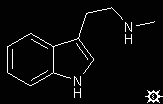
#50. NMT
TRYPTAMINE, N-METHYL; INDOLE, 3-[2-(METHYLAMINO)ETHYL]; N-METHYLTRYPTAMINE; 3-[2-(METHYLAMINO)ETHYL]INDOLE

|
| [3D .mol Image] |
A solution of 1.88 g N-formyltryptamine in 40 mL anhydrous Et2O was added to a 60 mL of a 1 N solution of LAH in THF, well-stirred under argon, and was held at reflux for 24 h. After cooling to room temperature, the excess hydrid was destroyed by the addition of 20 mL of 50% aqueous THF. The resulting solids were removed by filtration, and the filter cake washed repeatedly with damp THF. The basic filtrate was stripped of solvent under vacuum to give 1.39 g of a pale oil which started to crystallize. After distillation at 135-145 °C at 0.1 mm/Hg, there was obtained 1.22 g (70%) of N-methyltryptamine as a white oil that spontaneously set up to white crystals of the free base. These rapidly darkened on exposure to air. The infra-red spectral fingerprint was (in cm-1): 740, 1018, 1103, 1132, 1161. The literature mp is 90 °C. A 0.22 g sample of darkened base in 1.0 g IPA was neutralized with concentrated HCl (using external moistened pH paper as a titration guide) with the development of an intense blue-green color with the addition of each drop of acid. The acidified solution (now a stable blue-green color) was diluted with diethyl Et2O (about 1 mL). This cloudy solution, upon scratching, set to crystals which, upon removal by filtration, Et2O washing, and air drying to constant weight, weighed 0.18 g and had a mp of 178-180 °C. The IR of N-methyltryptamine hydrochloride (NMT), (in cm-1): 748, 850, 1009, 1104, 1119, 1136. MS (in m/z): C2H6N+ 44 (100%); indolemethylene+ 130, 131 (51%, 61%); parent ion 174 (2%).
EXTENSIONS AND COMMENTARY : N-Methyltryptamine (monomethyltryptamine, NMT) is an alkaloid that has been found in the bark, shoots and leaves of several species of Virola, Acacia and Mimosa. However, the major snuffs associated with these plant have been shown to also contain 5-MeO-DMT and are discussed there. NMT has been synthesized in a number of ways. One can react 3-(2-bromoethyl)indole with methylamine. NMT can be isolated as the benzoyl derivative from the methylation of tryptamine with methyl iodide followed by reaction with benzoyl chloride, with the hydrolysis of this amide with alcoholic KOH. It can also be synthesized from indole with oxalyl chloride, with the resulting glyoxyl chloride reacting with methylamine in ether to give indol-3-yl N-methylglyoxalylamide (mp 223-224 °C from IPA) which is obtained in a 68% yield, which is reduced to NMT to give the amine hydrochloride (mp 175-177 °C from EtOH) in a 75% yield. The most simple and direct synthesis is the formamide reduction given above.
To my knowledge there have been no reports of oral activity of NMT, although its wide availability from botanic sources has encouraged some explorers to assay it. I have had one report that the smoking of 50-100 mg gave visuals that lasted for maybe 15 seconds. The N-hydroxy analogue has been noted as being found in plants, in the "DMT is Everywhere" chapter.